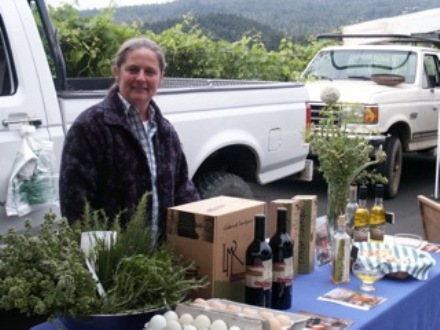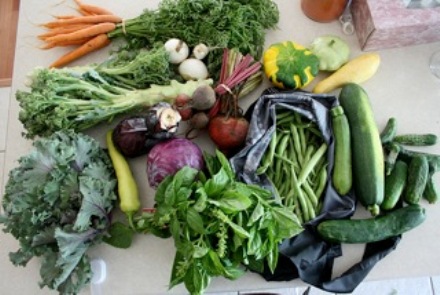Winegrowers Cash in on Other Crops
Napa vineyards find sustainable benefits by branching out

Napa, Calif. -- In what seems a return to yesterday, after years of concentrating on nothing but grapevines, many Napa Valley winegrowers are starting to grow other crops and even livestock. Their motivations range from passion to economics, but perhaps the most intriguing is to cultivate a better workforce.
Three top Napa vintners/growers discussed their vegetable, fruit and animal growing at the first Napa Valley Local Food Fair recently.
Ted Hall of Long Meadow Ranch owns a mountain property where he grows respected Cabernet and other grapes as well as olives, egg-laying chickens and Highland cattle. He also owns a commercial farm in Rutherford, in an area of rich soil that he says isn’t ideal for premium vines. The high water table and rich soils can produce excessive vegetative growth in the Cabernet vines for which Napa is most famous.
It must be noted that many Napa growers grow grapes in similar bottomlands, taking extra efforts to reduce vigor. Hall, who was raised on a farm in Pennsylvania, claims he makes more money per acre from his other crops than he would for grapes on this Rutherford acreage. He admits it’s a relatively small space that requires intense farming. “This isn’t philanthropy for foodies,” he asserts.
He also points out that other issues can make land more suitable for vegetables, fruits or pasture than for premium grapevines. Soils contaminated with boron, for example, which are common in northeastern Napa County, are fine for olives but not grapes.
Pierce's disease is an issue in Napa -- even without glassy-winged sharpshooters, since native blue-green sharpshooters also carry the disease. Vines killed by PD might advantageously be replaced by vegetable and fruit barriers: These properties are often near the river, where the soil is rich and well-watered anyway.
Hall and his wife Laddie have sold their produce at the St. Helena Farmers Market for years, and also have a farm stand on Highway 29 at their property.
This year, they opened a restaurant, tasting room and nursery complex called Farmstead in St. Helena -- Napa County doesn’t allow restaurants at farms. Hall plans to move his produce stand there and sell products from other growers, too.
Lee Hudson’s Hudson Vineyards in Carneros is famous for its premium grapes, particularly Chardonnay and Pinot Noir, but he also makes a little wine, grows vegetables and raises egg-laying poultry and pigs.
To try to make these efforts viable, he is attempting to create a distribution channel for local produce like that which once existed in the area. He just started selling produce direct-to-consumer through Community Supported Agriculture (CSA) boxes sent to subscribers. He even bought the produce market at Napa’s Oxbow Public Market to sell his and other producers’ crops.
Hudson, who was trained in horticulture, admits that part of his motivation is his passion for growing, but adds, “The first rule of sustainability is to be in business next year.” He regards this as a business, not a passion.

Perhaps the most compelling argument for growing other crops, however, comes from John Williams of Frog's Leap Winery, who was raised on a dairy farm in New York state and studied dairy science. He makes a good argument for commercial growing to improve his labor force. He can employ and train more people year-round and the workers who prune and pick grapes now work in the orchard and winery when they’re not busy in the vineyards.
He sells some of his vegetables to four restaurants, and also sells olive oil and honey in the winery’s tasting room, but much of the produce goes to employees as a perk. Williams doesn’t expect the revenue from what he sells to cover the cost of farming, in fact.
But he sees many benefits. For one, his diversified staff doesn’t require grounds-tending or landscaping services. The labor goes directly into the produce.
The biggest benefit, however, may be in allowing him to hire more people year-round. “The Mexican workforce has been wonderful for us, and we try to return that favor.”
The workers don’t have to be paid off after pruning in January until tying canes in May, or from leafing until harvest. In between, Williams’ workers can prune trees, turn compost, bottle Sauvignon Blanc, harvest broccoli, rack and wash barrels, thin pears and apples, bottle Merlot, etc. They work full time—and get paid, three-week vacations, 401(k) plans and health benefits. “We also have fewer safety issues, because they’re well-trained and experienced,” Williams says. “They’re an engaged and highly motivated workforce.”
He admits that scheduling and supervising takes more effort, but the grapes come first, then the winery, then the rest of the crops. “Are there higher overall labor costs?” he asks, “How can you really measure your labor costs? The workers get stable wages, they don’t have to worry about housing and healthcare and where their kids go to school. They’re a community of workers.”
He also says there are fewer problems with documentation, better health, less crime and use of the community’s safety net.
Williams also laughs that because the winery is closed on Sunday, he suspects he’s helping feed some others in Napa County, too.
These three grapegrowers report that the diversity of their farms helps organic farming, too. Larger animals provide manure for fertilizer, chickens and goats eat weeds, and chickens eat bugs. Truchard Vineyards raises goats and miniature burros to deter coyotes.
The gardens and animals attract visitors, too.
Many -- perhaps most -- other wineries in Napa Valley also raise vegetables for their food programs, staff and owners. St. Supéry Vineyards raises fruit and bees at its sprawling Dollarhide Ranch in Pope Valley, and sells the fruit and honey to local restaurants, for example. Round Pond Vineyards uses its crops in the wine and food programs—and for the staff and owners, who live on the property.
Hall, Hudson and Williams acknowledge that many growers don’t have the time, expertise or motivation to grow their own crops, but suggest a return to old-fashioned sharecropping. Many local people would apparently like to return to the land but can’t afford property in expensive Napa Valley.